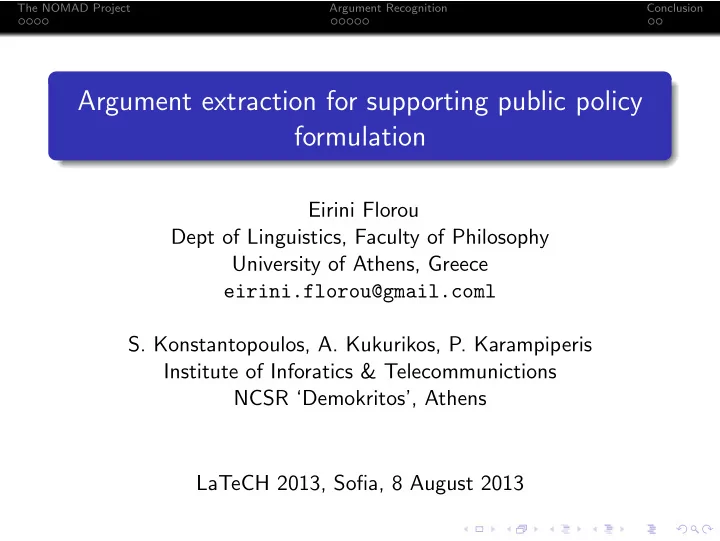

The NOMAD Project Argument Recognition Conclusion Argument extraction for supporting public policy formulation Eirini Florou Dept of Linguistics, Faculty of Philosophy University of Athens, Greece eirini.florou@gmail.coml S. Konstantopoulos, A. Kukurikos, P. Karampiperis Institute of Inforatics & Telecommunictions NCSR ‘Demokritos’, Athens LaTeCH 2013, Sofia, 8 August 2013
The NOMAD Project Argument Recognition Conclusion Overview The NOMAD Project 1 Argument Recognition 2 Conclusion 3
The NOMAD Project Argument Recognition Conclusion Support for and opposition to unpublished policy drafts Conventional opinion mining: Formulate a policy and publish a draft Crawl the Web for relevant material Aggregate per topic and sentiment The NOMAD idea is applicable at an earlier stage: Formulate a policy Annotate policy items with relevant arguments General political statements Both in favour and against the policy regardless of the policy maker’s own stance Crawl and analyse material relevant to the arguments Positive sentiment for the argument is an estimator of support for the policy item
The NOMAD Project Argument Recognition Conclusion Extracting arguments Crawl and analyse material relevant to the arguments Positive sentiment for the argument is an estimator of support for the policy item Crawl for arguments that are supporting/opposing the policy arguments Arguments indicate opinionated text Summaries of relevant arguments are more useful input Supporting arguments are more accurate and more useful estimators of support for the policy item
The NOMAD Project Argument Recognition Conclusion Example Incentives for increasing the market penetration of wind power. Policy arguments: Greenhouse gas emissions should not be a concern at all. Greenhouse gas emissions should be reduced, but this should be balanced against other concerns. Greenhouse gas emissions should be reduced at all costs. No textual/semantic similarity, but relevant: In case hard packaging is made compulsory by law, producers will be forced to consume more energy, leading to more greenhouse gas emissions. Tidal power production does not emit greenhouse gases, but other environmental problems are associated with its widespread deployment.
The NOMAD Project Argument Recognition Conclusion The NOMAD processing pipeline Web crawling, HTML cleaning, Tokenization Sentence splitting Term lookup and disambiguation Semantic segmentation Maximal chunks of contiguous, full sentences that are semantically relevant to policy argument Argument extraction Classify chunks as being argumentative or not Extract structure and polarity For English, Greek, and German. This paper is about argument recognition for Greek.
The NOMAD Project Argument Recognition Conclusion Looking for arguments Variety of approaches: argument structure lexicons, patterns. Semantic role analysis to assign structure to opinions. Most often boils down to disource markers that correspond to the connectives between the elements of argument structure: if, because, therefore, etc. also longer phrases: this goes to show, it naturally follows that, etc.
The NOMAD Project Argument Recognition Conclusion Tense Our hypothesis is that future and conditional tenses and moods often indicate conjectures and hypotheses which are commonly used in argumentation Experimental setup: Greek language texts Crawled, segmented as discussed above Manually annotated as arguments PoS-tagging, chunking JAPE grammar PoS tags of main and aux verbs in the verb chunk assigns tense and mood to the chunk
The NOMAD Project Argument Recognition Conclusion Features Label Description Features DM Absolute number of occurrences of 5 numerical discourse markers from a given category Rel Relative frequency of each of the 6 tenses 12 numerical and each of the 6 moods RCm Relative frequency of each tense/mood 9 numerical combination (only for those that actually appear). Bin Appearance of each of the 6 tenses 12 binary and each of the 6 moods Dom Most frequent tense, mood, and 3 string tense/mood combination TOTAL 41 features
The NOMAD Project Argument Recognition Conclusion Experimental setup 677 text segments between 10 and 100 words, avg. 60 words 345 positive, 332 negative results reported are 10-fold average
The NOMAD Project Argument Recognition Conclusion Results Morpho-syntactic With Discourse Markers Without Discourse Markers features used Prec. Rec. F β =1 Prec. Rec. F β =1 All 75.8% 71.9% 73.8% 75.5% 70.4% 72.9% no Dom 79.8% 73.3% 76.4% 74.0% 71.9% 72.9% no Rel 74.5% 72.8% 73.8% 73.1% 69.3% 71.1% no RCm 76.3% 71.0% 73.6% 76.8% 70.1% 73.3% no Bin 70.0% 70.4% 70.2% 66.7% 69.6% 68.1% Rel 73.4% 75.9% 74.6% 70.3% 72.2% 71.2% Dom 57.1% 98.8% 72.4% 54.9% 94.2% 69.4% RCm 69.3% 66.7% 67.9% 71.9% 62.9% 67.1% Bin 71.7% 49.9% 58.8% 70.1% 44.9% 54.8% None 67.9% 20.9% 31.9% —
The NOMAD Project Argument Recognition Conclusion Conclusion LT assistance for policy formulation: Use Web content to assess policy draft before public consultation. Cannot classify Web content as similar to policy Look for public opinion wrt. more general concepts Argument extraction: Core contribution: verb tense and mood are significant features Not explored previously Publicly available resources: JAPE grammar for tense/mood from PoS tags and chunking Manually annotated corpus
The NOMAD Project Argument Recognition Conclusion Conclusion Thank you for your attention. Questions?
Recommend
More recommend